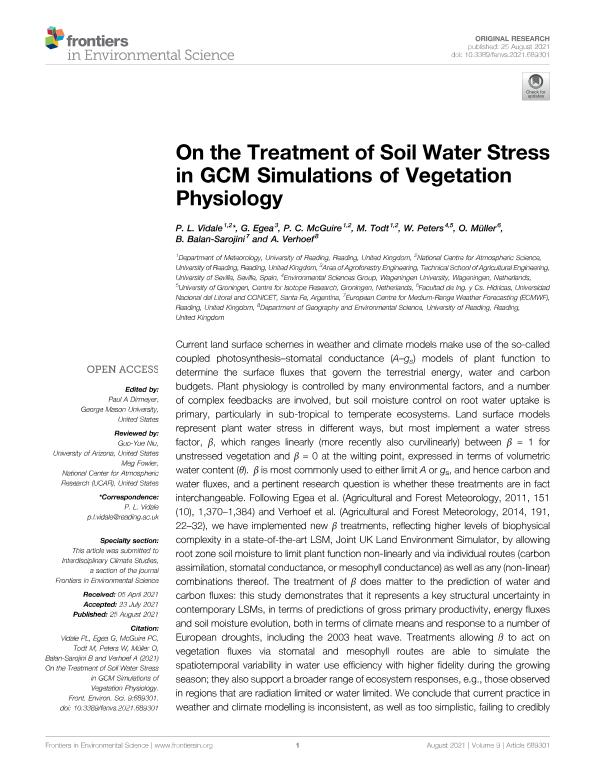Artículo
On the Treatment of Soil Water Stress in GCM Simulations of Vegetation Physiology
Vidale, Pier Luigi; Egea, G.; McGuire, Patrick; Todt, Markus; Peters, Wouter; Müller, Omar Vicente ; Balan Sarojini, B.; Verhoef, Anne
; Balan Sarojini, B.; Verhoef, Anne
 ; Balan Sarojini, B.; Verhoef, Anne
; Balan Sarojini, B.; Verhoef, Anne
Fecha de publicación:
08/2021
Editorial:
Frontiers Media
Revista:
Frontiers in Environmental Science
e-ISSN:
2296-665X
Idioma:
Inglés
Tipo de recurso:
Artículo publicado
Clasificación temática:
Resumen
Current land surface schemes in weather and climate models make use of the so-called coupled photosynthesis–stomatal conductance (A–gs) models of plant function to determine the surface fluxes that govern the terrestrial energy, water and carbon budgets. Plant physiology is controlled by many environmental factors, and a number of complex feedbacks are involved, but soil moisture control on root water uptake is primary, particularly in sub-tropical to temperate ecosystems. Land surface models represent plant water stress in different ways, but most implement a water stress factor, β, which ranges linearly (more recently also curvilinearly) between β 1 for unstressed vegetation and β 0 at the wilting point, expressed in terms of volumetric water content (θ). β is most commonly used to either limit A or gs, and hence carbon and water fluxes, and a pertinent research question is whether these treatments are in fact interchangeable. Following Egea et al. (Agricultural and Forest Meteorology, 2011, 151 (10), 1,370–1,384) and Verhoef et al. (Agricultural and Forest Meteorology, 2014, 191, 22–32), we have implemented new β treatments, reflecting higher levels of biophysical complexity in a state-of-the-art LSM, Joint UK Land Environment Simulator, by allowing root zone soil moisture to limit plant function non-linearly and via individual routes (carbon assimilation, stomatal conductance, or mesophyll conductance) as well as any (non-linear) combinations thereof. The treatment of β does matter to the prediction of water and carbon fluxes: this study demonstrates that it represents a key structural uncertainty in contemporary LSMs, in terms of predictions of gross primary productivity, energy fluxes and soil moisture evolution, both in terms of climate means and response to a number of European droughts, including the 2003 heat wave. Treatments allowing ß to act on vegetation fluxes via stomatal and mesophyll routes are able to simulate the spatiotemporal variability in water use efficiency with higher fidelity during the growing season; they also support a broader range of ecosystem responses, e.g., those observed in regions that are radiation limited or water limited. We conclude that current practice in weather and climate modelling is inconsistent, as well as too simplistic, failing to credibly simulate vegetation response to soil water stress across the typical range of variability that is encountered for current European weather and climate conditions, including extremes of land surface temperature and soil moisture drought. A generalized approach performs better in current climate conditions and promises to be, based on responses to recently observed extremes, more trustworthy for predicting the impacts of climate change.
Archivos asociados
Licencia
Identificadores
Colecciones
Articulos(CCT - SANTA FE)
Articulos de CTRO.CIENTIFICO TECNOL.CONICET - SANTA FE
Articulos de CTRO.CIENTIFICO TECNOL.CONICET - SANTA FE
Citación
Vidale, Pier Luigi; Egea, G.; McGuire, Patrick; Todt, Markus; Peters, Wouter; et al.; On the Treatment of Soil Water Stress in GCM Simulations of Vegetation Physiology; Frontiers Media; Frontiers in Environmental Science; 9; 8-2021; 1-23
Compartir
Altmétricas



